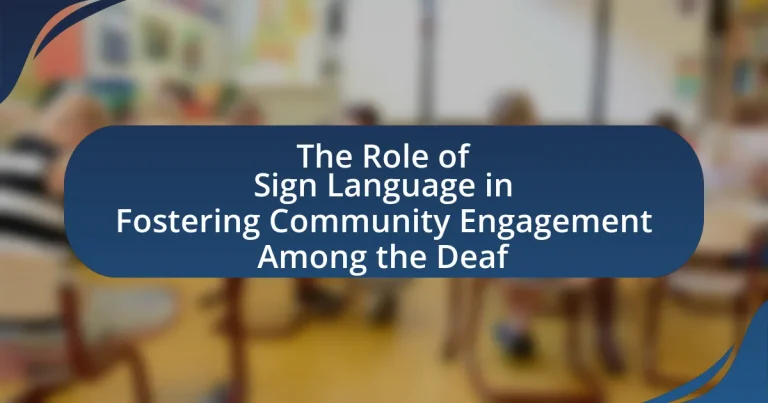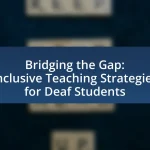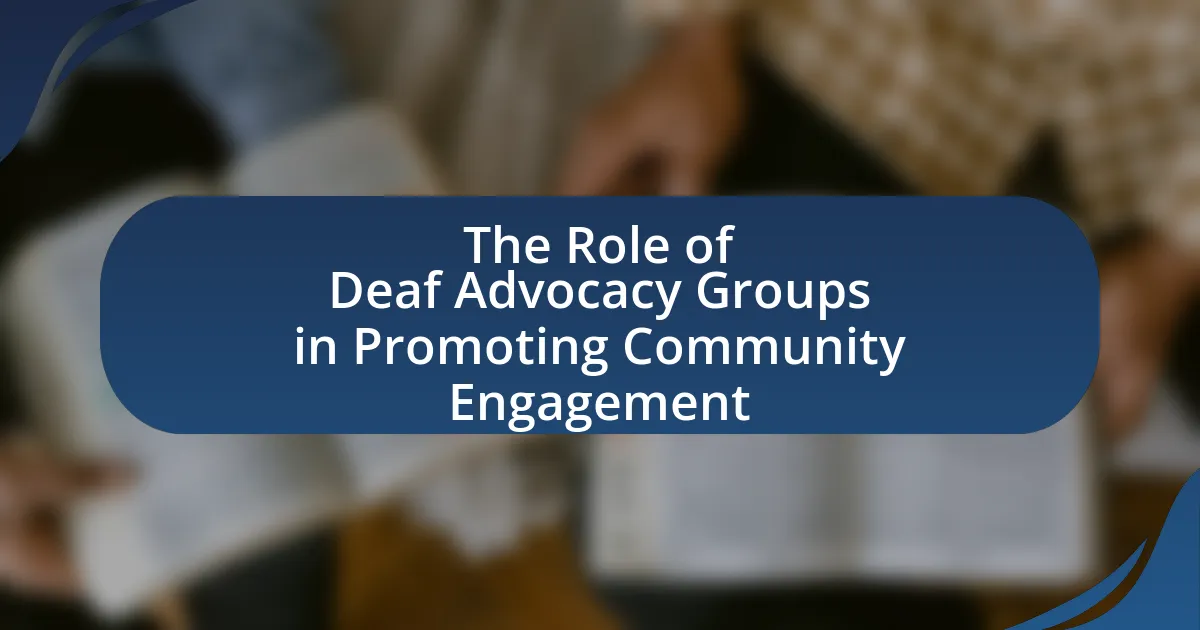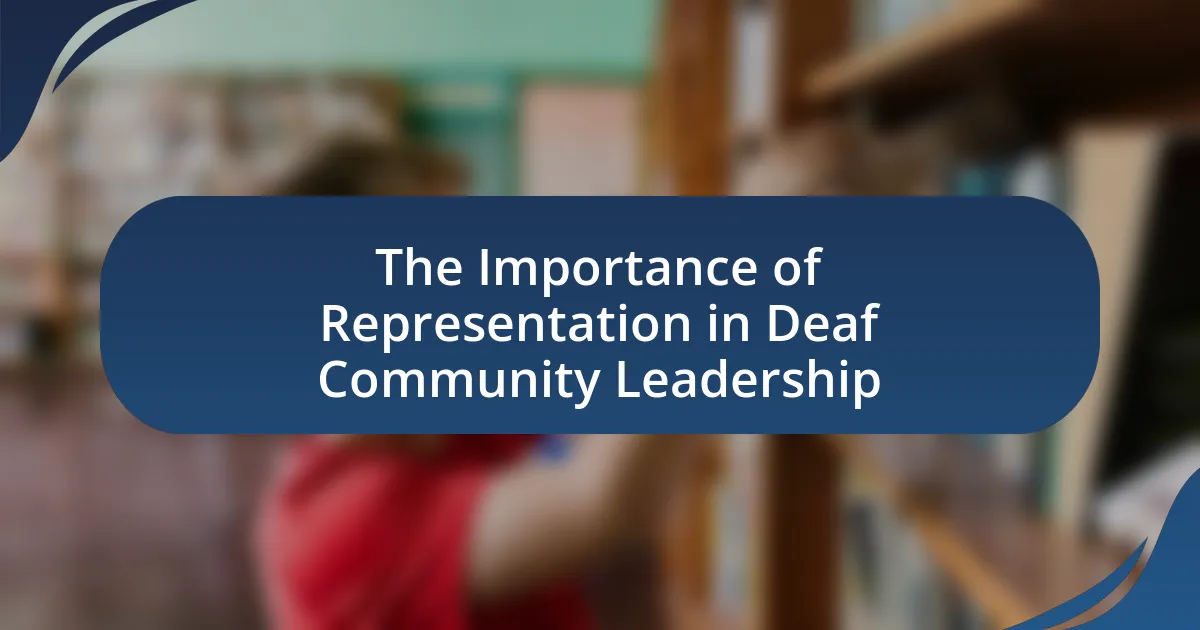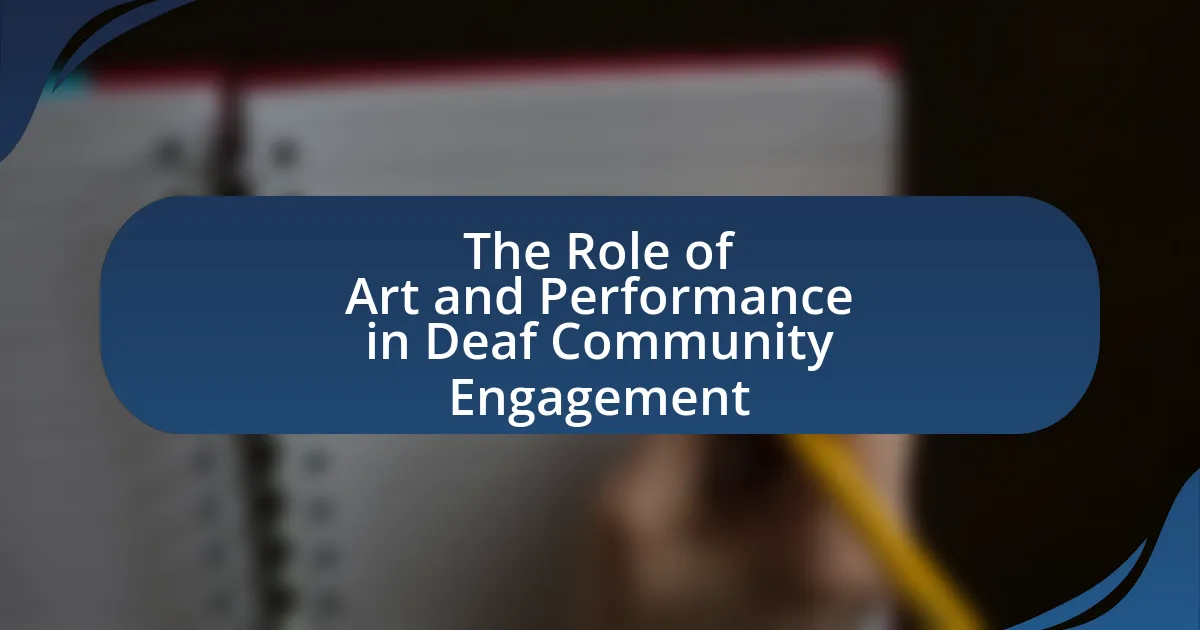Sign language is a vital tool for fostering community engagement among Deaf individuals, facilitating communication, social interaction, and inclusion. The article explores how sign language enhances connections within the Deaf community, promotes identity, and improves mental health through active participation in community activities. It addresses the challenges Deaf individuals face, such as communication barriers and societal attitudes, while highlighting the importance of sign language education and community programs in promoting inclusivity. Additionally, the article discusses the role of technology in supporting sign language use and offers practical steps for individuals and communities to enhance engagement through sign language initiatives.
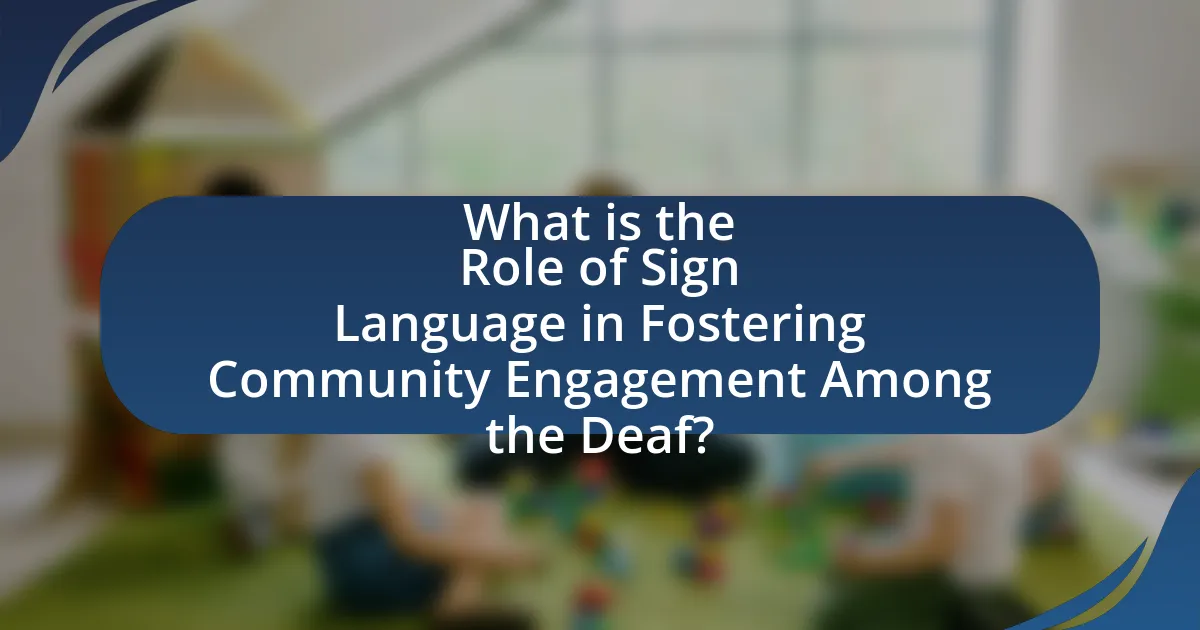
What is the Role of Sign Language in Fostering Community Engagement Among the Deaf?
Sign language plays a crucial role in fostering community engagement among the Deaf by providing a shared mode of communication that enhances social interaction and inclusion. This shared language allows Deaf individuals to connect with one another, participate in community events, and advocate for their rights, thereby strengthening community bonds. Research indicates that communities with accessible sign language resources experience higher levels of participation and cohesion among Deaf members, as evidenced by studies showing that Deaf individuals who use sign language are more likely to engage in social activities and support networks.
How does sign language facilitate communication within the Deaf community?
Sign language facilitates communication within the Deaf community by providing a visual and gestural means of expression that is accessible to its members. This form of communication allows Deaf individuals to convey complex ideas, emotions, and information effectively, fostering social interaction and community bonding. Research indicates that sign language enhances cognitive processing and social engagement among Deaf individuals, as it enables them to participate fully in conversations and cultural exchanges. For instance, studies show that sign language users often experience a stronger sense of identity and belonging, which is crucial for community cohesion.
What are the key features of sign language that enhance communication?
The key features of sign language that enhance communication include visual-gestural modality, expressiveness, and the use of space. Sign language relies on hand shapes, facial expressions, and body movements to convey meaning, allowing for rich and nuanced communication. This visual nature enables users to express emotions and concepts that may be difficult to articulate verbally. Additionally, the spatial aspect of sign language allows for the representation of relationships and actions in a three-dimensional context, facilitating clearer understanding among users. Research indicates that these features contribute to effective communication within the Deaf community, fostering social connections and engagement.
How does sign language differ from spoken language in community settings?
Sign language differs from spoken language in community settings primarily through its visual-gestural modality, which facilitates communication among Deaf individuals in a way that spoken language cannot. In community settings, sign language allows for immediate and direct interaction, fostering a sense of belonging and inclusivity among Deaf participants. Research indicates that sign language promotes social cohesion and engagement, as it is often used in group settings where visual cues enhance understanding and participation. For example, studies show that Deaf communities utilize sign language to create shared cultural experiences, reinforcing identity and community bonds that spoken language may not achieve in the same manner.
Why is community engagement important for the Deaf?
Community engagement is important for the Deaf because it fosters social inclusion, enhances communication, and strengthens identity within the Deaf community. Engaging with others allows Deaf individuals to share experiences, access resources, and participate in cultural activities that affirm their identity. Research indicates that social connections significantly improve mental health and well-being among Deaf individuals, as highlighted in a study by the National Institute on Deafness and Other Communication Disorders, which found that social isolation can lead to increased feelings of loneliness and depression. Therefore, community engagement not only promotes a sense of belonging but also contributes to the overall quality of life for Deaf individuals.
What are the social benefits of community engagement for Deaf individuals?
Community engagement provides Deaf individuals with enhanced social connections, reducing feelings of isolation and fostering a sense of belonging. By participating in community activities, Deaf individuals can build relationships with peers who share similar experiences, which is crucial for mental well-being. Research indicates that social interactions through community involvement lead to improved self-esteem and increased opportunities for collaboration, as evidenced by studies showing that Deaf individuals who engage in community events report higher levels of satisfaction in their social lives. Furthermore, community engagement often promotes the use of sign language, facilitating better communication and understanding among participants, which strengthens social bonds and encourages inclusivity.
How does community engagement impact mental health among the Deaf?
Community engagement significantly enhances mental health among the Deaf by fostering social connections and reducing feelings of isolation. Research indicates that active participation in community activities leads to improved emotional well-being, as individuals experience a sense of belonging and support. For instance, a study published in the Journal of Deaf Studies and Deaf Education found that Deaf individuals who engage in community events report lower levels of depression and anxiety compared to those who do not participate. This correlation highlights the importance of social interaction and support networks in promoting mental health within the Deaf community.
What challenges do Deaf individuals face in community engagement?
Deaf individuals face significant challenges in community engagement primarily due to communication barriers. These barriers often stem from the lack of accessibility to sign language interpreters in public events and services, which limits their ability to participate fully. Additionally, societal attitudes and misconceptions about deafness can lead to social isolation and exclusion from community activities. Research indicates that approximately 70% of Deaf individuals report feeling excluded from social interactions due to communication difficulties, highlighting the need for improved accessibility and awareness in community settings.
How do societal attitudes affect the participation of Deaf individuals?
Societal attitudes significantly impact the participation of Deaf individuals by influencing their access to opportunities and social inclusion. Negative perceptions, such as viewing Deafness as a deficiency, can lead to discrimination and reduced opportunities for engagement in various activities, including education and employment. For instance, a study by the National Deaf Center on Postsecondary Outcomes found that positive societal attitudes correlate with higher rates of educational attainment and employment among Deaf individuals. Conversely, environments that lack awareness or acceptance of Deaf culture and sign language can create barriers, limiting participation in community events and social interactions.
What barriers exist in accessing community resources for the Deaf?
Barriers in accessing community resources for the Deaf include communication challenges, lack of awareness among service providers, and insufficient availability of sign language interpreters. Communication challenges arise when resources do not offer materials or services in accessible formats, making it difficult for Deaf individuals to engage fully. Additionally, many service providers may not understand the needs of the Deaf community, leading to inadequate support and resources. A study by the National Association of the Deaf highlights that 70% of Deaf individuals report difficulties in accessing healthcare services due to the absence of qualified interpreters, further illustrating the systemic barriers faced.
How can sign language education improve community engagement?
Sign language education can improve community engagement by fostering inclusivity and enhancing communication among diverse groups. When individuals learn sign language, they become more capable of interacting with Deaf community members, which promotes understanding and collaboration. Research indicates that communities with accessible sign language education experience increased participation in social events and activities, as evidenced by a study published in the Journal of Deaf Studies and Deaf Education, which found that inclusive environments lead to higher engagement levels among both Deaf and hearing individuals. This mutual understanding cultivates stronger community ties and encourages collective participation in local initiatives.
What role do schools play in promoting sign language among hearing individuals?
Schools play a crucial role in promoting sign language among hearing individuals by integrating it into their curricula and fostering an inclusive environment. By offering sign language classes and workshops, schools provide hearing students with the opportunity to learn and communicate with Deaf peers, thereby enhancing social interaction and understanding. Research indicates that early exposure to sign language can improve cognitive skills and empathy in hearing individuals, as evidenced by studies showing that bilingual education, including sign language, leads to better academic performance and social skills. Furthermore, schools often host events that celebrate Deaf culture, which helps to raise awareness and appreciation for sign language within the broader community.
How can community programs incorporate sign language to foster inclusivity?
Community programs can incorporate sign language by offering classes and workshops that teach both staff and participants basic sign language skills. This approach ensures effective communication with Deaf individuals, promoting their active participation in community activities. Research indicates that inclusive environments, where sign language is utilized, significantly enhance engagement and social interaction among Deaf individuals, as evidenced by a study published in the Journal of Deaf Studies and Deaf Education, which found that communities using sign language reported higher levels of satisfaction and belonging among Deaf members.
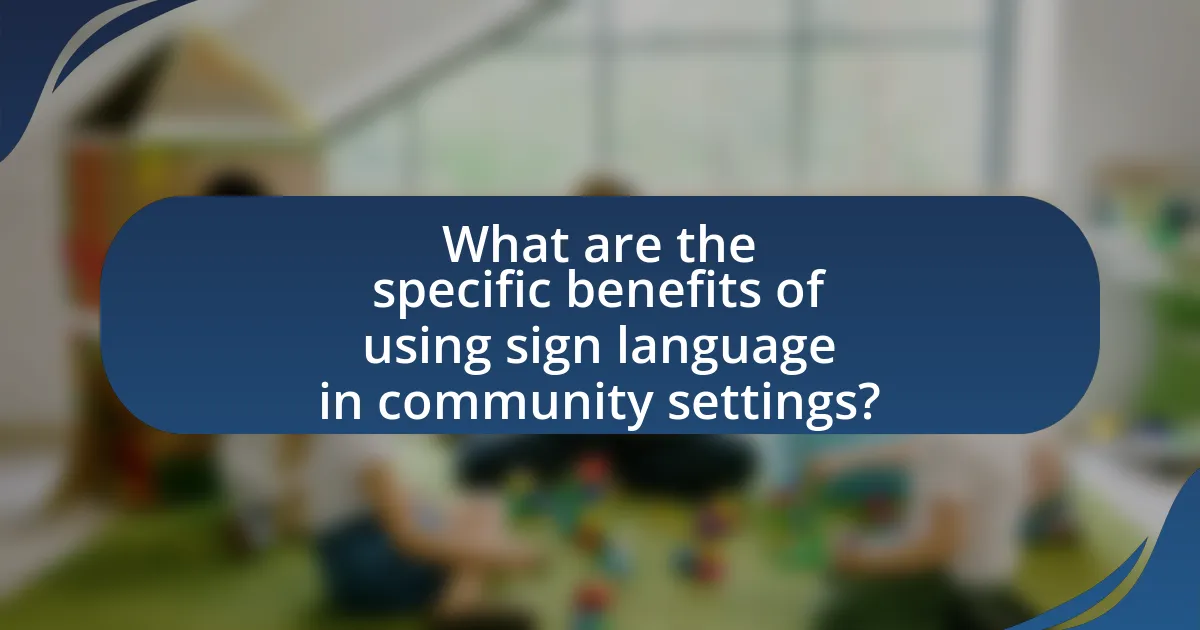
What are the specific benefits of using sign language in community settings?
Using sign language in community settings enhances communication accessibility, fostering inclusivity for Deaf individuals. This accessibility allows Deaf community members to participate fully in social, educational, and civic activities, thereby strengthening community bonds. Research indicates that communities utilizing sign language experience improved social cohesion, as evidenced by a study published in the Journal of Deaf Studies and Deaf Education, which found that sign language use significantly increases engagement and interaction among Deaf individuals and their hearing peers. Additionally, sign language promotes cultural identity and pride within the Deaf community, further enriching community dynamics.
How does sign language promote inclusivity in community events?
Sign language promotes inclusivity in community events by enabling effective communication between deaf and hearing individuals. This form of communication ensures that deaf participants can fully engage in discussions, activities, and social interactions, thereby fostering a sense of belonging. Research indicates that events incorporating sign language see increased participation from deaf individuals, as they feel more welcomed and understood. For instance, a study published in the Journal of Deaf Studies and Deaf Education highlights that community events with sign language interpreters significantly enhance the experience for deaf attendees, leading to higher satisfaction and engagement levels.
What types of community events benefit most from sign language interpretation?
Community events that benefit most from sign language interpretation include public meetings, educational workshops, cultural festivals, and performances. These events often involve information sharing and social interaction, which are crucial for engagement. For instance, public meetings allow for community members to voice concerns and participate in discussions, while educational workshops provide learning opportunities that should be accessible to all. Cultural festivals and performances enhance community cohesion and celebrate diversity, making it essential for Deaf individuals to fully participate. Research indicates that accessibility in these contexts significantly improves engagement and inclusion for Deaf participants, fostering a more connected community.
How can sign language enhance the experience of Deaf participants in community activities?
Sign language enhances the experience of Deaf participants in community activities by facilitating effective communication and fostering inclusion. When Deaf individuals can communicate in their native language, they are more likely to engage fully in discussions, share their thoughts, and participate in decision-making processes. Research indicates that inclusive environments, where sign language is used, lead to higher levels of satisfaction and participation among Deaf individuals, as they feel valued and understood. For instance, a study published in the Journal of Deaf Studies and Deaf Education found that Deaf participants reported increased social interaction and a sense of belonging when sign language was incorporated into community events. This demonstrates that sign language not only improves communication but also strengthens community ties for Deaf individuals.
What role does technology play in supporting sign language use?
Technology plays a crucial role in supporting sign language use by enhancing communication accessibility for the Deaf community. Tools such as video conferencing platforms, mobile applications, and social media enable real-time sign language interpretation and facilitate connections among users. For instance, video relay services allow Deaf individuals to communicate with hearing people through sign language interpreters, significantly improving interaction quality. Additionally, educational technologies, like online courses and interactive apps, provide resources for learning sign language, thereby promoting its use and fostering community engagement.
How do apps and online platforms facilitate sign language learning?
Apps and online platforms facilitate sign language learning by providing interactive and accessible resources that enhance the learning experience. These digital tools often include video tutorials, quizzes, and community forums, allowing users to practice sign language in real-time and receive feedback from peers and instructors. For instance, platforms like SignSchool and ASL App offer structured lessons and visual aids that cater to various learning styles, making it easier for individuals to grasp complex signs and concepts. Additionally, research indicates that online learning environments can increase engagement and retention rates, as users can learn at their own pace and revisit materials as needed.
What technological advancements have improved communication for the Deaf community?
Technological advancements such as video relay services (VRS), real-time text (RTT), and mobile applications have significantly improved communication for the Deaf community. VRS allows Deaf individuals to communicate with hearing people through a sign language interpreter via video calls, enhancing accessibility and immediacy in conversations. Real-time text enables text messages to be sent instantly as they are typed, facilitating smoother communication. Additionally, mobile applications like Glide and Sorenson’s ZVRS provide platforms for video calls and messaging, further connecting the Deaf community. These technologies have transformed communication dynamics, making interactions more efficient and inclusive.
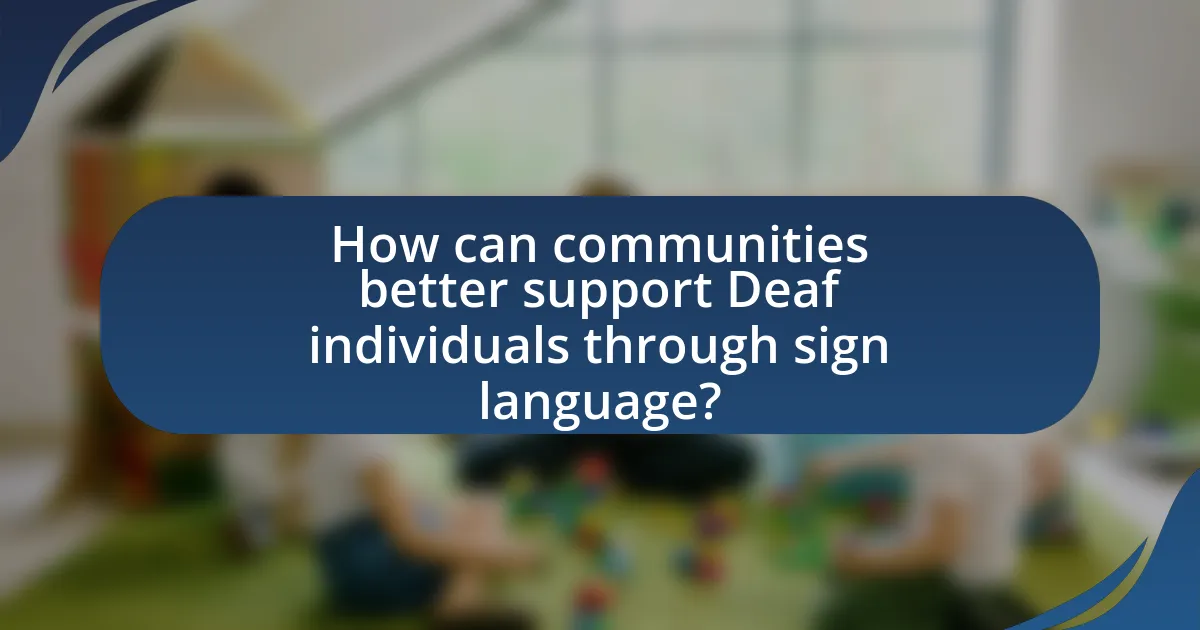
How can communities better support Deaf individuals through sign language?
Communities can better support Deaf individuals through sign language by providing accessible sign language education and resources. Offering classes in American Sign Language (ASL) or other relevant sign languages enables hearing individuals to communicate effectively with Deaf community members, fostering inclusion. Research indicates that increased sign language proficiency among hearing individuals leads to improved social interactions and relationships with Deaf individuals, enhancing community engagement. For instance, a study published in the Journal of Deaf Studies and Deaf Education found that communities with higher rates of sign language education reported stronger connections between Deaf and hearing residents.
What best practices should communities adopt to promote sign language use?
Communities should adopt inclusive educational programs to promote sign language use. Implementing sign language classes in schools and community centers can enhance awareness and proficiency among both deaf and hearing individuals. Research indicates that early exposure to sign language improves communication skills and fosters social inclusion, as seen in studies conducted by the National Institute on Deafness and Other Communication Disorders. Additionally, hosting community events that celebrate deaf culture and sign language can create a supportive environment, encouraging more people to learn and use sign language in everyday interactions.
How can local governments support sign language initiatives?
Local governments can support sign language initiatives by implementing policies that promote accessibility and inclusion for the Deaf community. This can include funding sign language education programs in schools, providing resources for training interpreters, and ensuring public services are equipped with sign language support. For instance, the National Association of the Deaf reports that access to sign language education significantly improves communication and engagement for Deaf individuals, fostering a more inclusive community. Additionally, local governments can collaborate with Deaf organizations to create awareness campaigns that highlight the importance of sign language, further enhancing community engagement.
What resources are available for communities to learn about sign language?
Communities can access various resources to learn about sign language, including online courses, local classes, and educational materials. Websites like ASL University and the National Association of the Deaf offer structured courses and tutorials. Additionally, community colleges and adult education centers frequently provide sign language classes. Libraries often have books and videos on sign language, while social media platforms host groups and forums for practice and support. These resources facilitate learning and promote engagement within the Deaf community.
What practical steps can individuals take to foster community engagement through sign language?
Individuals can foster community engagement through sign language by organizing inclusive events that incorporate sign language interpretation and offering sign language classes to the community. These events, such as workshops, social gatherings, or cultural festivals, create opportunities for interaction between deaf and hearing individuals, promoting understanding and collaboration. Providing sign language classes increases awareness and accessibility, enabling more people to communicate with the deaf community. Research indicates that inclusive practices enhance social cohesion and reduce barriers, as evidenced by studies showing that communities with active sign language programs report higher levels of engagement and mutual support among diverse groups.
How can hearing individuals learn sign language to support Deaf friends and family?
Hearing individuals can learn sign language through various methods such as enrolling in formal classes, utilizing online resources, and practicing with Deaf friends and family. Formal classes often provide structured learning environments with qualified instructors, while online resources, including video tutorials and mobile applications, offer flexibility and accessibility. Engaging in regular practice with Deaf individuals enhances fluency and builds confidence in using sign language. Research indicates that immersive experiences, such as attending Deaf community events, significantly improve language acquisition and cultural understanding, fostering stronger relationships and community engagement.
What are effective ways to advocate for sign language inclusion in community programs?
Effective ways to advocate for sign language inclusion in community programs include raising awareness through educational workshops, collaborating with local organizations, and promoting policy changes that support accessibility. Educational workshops can inform community members about the importance of sign language, fostering understanding and empathy. Collaborating with local organizations, such as schools and advocacy groups, can amplify efforts and create a unified voice for inclusion. Additionally, advocating for policy changes, such as requiring sign language interpreters at public events, can institutionalize support for the Deaf community, ensuring their participation in community programs. These strategies are supported by research indicating that inclusive practices enhance community engagement and improve social cohesion among diverse populations.
